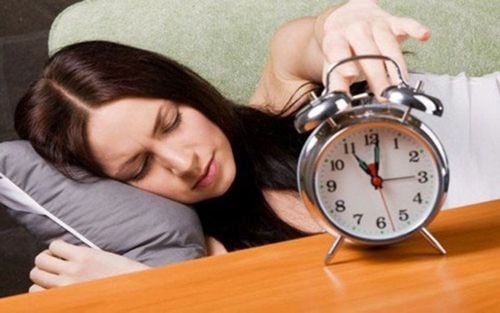This is an automatically translated article.
Sleepwalking - a disorder that makes it possible for the patient to stand up and walk while sleeping. It usually occurs when a person is transitioning from a deep sleep to a waking stage. Sleepwalking mainly occurs in children between the ages of 4 and 8. But it can still happen in adults. The article will provide more information about this disease to help you prevent and treat it effectively.
1. Sleepwalking
Sleepwalking - behavioral disturbance that originates in deep sleep and leads to walking or other complex behaviors while mostly still asleep. It is more common in children than adults and is more likely to occur if a person has a family history of the condition, is sleep deprived, or is prone to frequent nighttime awakenings.
Accidents during these episodes can cause trauma, and sleepwalking has been linked to worse sleep and daytime sleepiness. Aggressive treatment may not be necessary for many people, but when exacerbations are more frequent or more intense, several treatment options may be beneficial.
What is sleepwalking? Sleepwalking - a type of sleep disorder or parasitic sleep disorder. Sleep disorders often occur with unusual behaviors during sleep. These disorders straddle the line between sleep and wakefulness, so actions occur during irregular episodes of insomnia. Sleep disorders can be classified based on the part of the sleep cycle in which they occur. Sleepwalking occurs during non-REM (NREM) sleep, usually during stage III of the sleep cycle, also known as deep sleep. Along with other sleep disorders such as sleep speech, arousal disorder, and sleep terrors, sleepwalking is classified as an NREM arousal disorder.
2. Symptoms of sleepwalking
Why sleepwalking? The symptoms of sleepwalking can be related to a variety of simple or complex actions that a person performs while mostly still asleep. Patients may have wide glassy eyes with a blank expression and often react incoherently in their speech.
Sleepwalking is not limited to just walking, but there are other types of actions that can happen and remain under the cover of sleepwalking. Examples include running, routine actions such as dressing, moving furniture, performing sexual acts (insomnia), or urinating in inappropriate places. Or there may be less frequent behaviors such as potentially violent or potentially more complex behaviors, including attempting to drive a car.
Sleepwalking episodes can last for a few seconds to half an hour with most ending in less than 10 minutes. The person may go back to bed and continue to sleep, or may wake up confused before getting out of bed.
A major symptom of sleepwalking and other NREM sleep disorders is that the person almost never recalls sleepwalking when they wake up. For that reason, people often learn about their sleepwalking from a family member or housemate.
Another common factor of NREM sleep disturbances usually occurs during the first third or midnight as a person tends to spend a higher percentage of time in the NREM deep sleep phase.

Người mộng du hầu như không nhớ những việc mình làm khi họ thức dậy
3. The prevalence of sleepwalking
Sleepwalking occurs more often in children than in adults. One long-term study found that 29% of children between the ages of 2 and 13 experienced sleepwalking, with the highest prevalence between the ages of 10 and 13. In adults, the estimated prevalence was as high as 4%. Sleepwalkers don't remember episodes making it challenging to pinpoint exactly how often it happens. In addition, studies sometimes define sleepwalking in different ways.
4. Dangers of sleepwalking
Sleepwalking can have serious health consequences. Injury can occur if a person walks and falls or collides with something while walking or running, or a life-threatening situation can occur. Violent behavior can harm the sleepwalker or others.
Actions during sleepwalking can bring on feelings of shame. For example, a person may feel embarrassed about pornographic behavior, violent outbursts, or misplaced urination.
Studies have found that sleepwalkers have excessive levels of daytime sleepiness and insomnia symptoms. It is not known whether these problems arise from actual disturbances from sleepwalking or if there is an underlying factor affecting their sleep that puts them at risk of both sleepwalking and daytime sleepiness.
Additionally, sleepwalking can have consequences for bedmates, roommates and/or housemates. The occurrence of sleepwalking can disrupt their sleep, and they can be negatively affected by a person's behavior during episodes.
5. Causes of sleepwalking
Sleep experts believe that sleepwalking usually occurs when a person is in a deep sleep phase and is partially awakened in a way that triggers physical activity while mostly asleep. Various factors influence the likelihood of this pattern of partial awakening:
Genetics and family history: Studies show a clear pattern in which some people are genetically predisposed to the syndrome sleepwalking and other NREM sleep disorders. About 22% of children whose parents have no history of sleepwalking experience the condition. In contrast, 47% of children sleepwalking if one parent has a history of the condition, and 61% of children sleepwalking if both parents have it. Sleep deprivation: Sleep deprivation has been linked to a higher risk of sleepwalking, possibly because it takes longer to fall asleep after a period of sleep deprivation. Certain medications: Drugs with sedative effects can push people into a sleep pattern that increases the likelihood of sleepwalking. Alcohol: Drinking alcohol in the evening can create instability in a person's sleep phase and may increase the risk of sleepwalking. Brain injury: Conditions affecting the brain, including brain swelling (encephalitis 6), can be a cause of sleepwalking. Fever: In children, fever has been found to increase the likelihood of sleepwalking and it may be related to an increased number of nocturnal morbid stimuli. Obstructive Sleep Apnea (OSA): OSA is a sleep disorder in which the airways become blocked, making it difficult to breathe during sleep. These pauses, which can occur dozens of times per night, create sleep disruptions and can lead to sleepwalking. Restless Legs Syndrome (RLS): RLS is a sleep disorder that causes a feeling of wanting to move the limbs, especially the legs, when lying down. It causes nighttime arousal, from which a person can go into sleepwalking. Stress: Many different types of stress can affect sleep, including causing more sporadic or disrupted sleep that can increase the tendency to sleepwalk. Stress can be physical, such as from pain or emotion. Some types of stress can be associated with discomfort or change, such as when traveling and sleeping in an unfamiliar place. Children who sleepwalk may find that episodes stop happening as they get older, or they may continue to sleepwalk into adulthood. Although most sleepwalking begins in childhood, the condition can also begin in adulthood.

Tình trạng thiếu ngủ có thể liên quan đến chứng mộng du
6. Sleepwalking treatment
Treatment of sleepwalking depends on the patient's age, frequency, and severity or severity of the episodes. For children and adults, it's best to raise concerns about sleepwalking with a doctor, who can work to find the most likely cause and develop an appropriate treatment plan.
In many cases, sleepwalking does not require active treatment because episodes are rare and pose little danger to the sleeper or those around him. Sleepwalking episodes are less common with age, so for some people, sleepwalking will resolve on its own with any specific therapy.
Eliminate safety risks. Reducing the harmful effects of sleepwalking is considered an important consideration for sleepwalkers. Some ways to reduce safety risks include:
Keep sharp objects or weapons out of reach and out of reach Close and latch doors including doors and windows Eliminate tripping hazards get off the floor Install lights that use motion sensors Use a doorbell or a bedtime alarm if the person gets out of bed Treat underlying causes
If a person's sleepwalking is linked to the disorder such as OSA or RLS, treating the condition may resolve the sleepwalking. Similarly, if the use of sedatives or other medications is contributing to sleepwalking, your doctor may recommend that you change the dose or switch to a different medication.
Predictive Awakening
Predictive Awakening-waking someone just before potential sleepwalking is likely. Because sleepwalking is associated with a specific stage of sleep, it usually happens at the same time each night. Waking someone up just before that time can prevent them from being awakened partially that can cause sleepwalking. Anticipated awakening has been effective in helping many children stop sleepwalking and may be helpful for others, but has not been carefully studied in adult patients.
Improve sleep hygiene
Sleep hygiene refers to a person's sleep-related environment and habits. Poor sleep hygiene, such as having an inconsistent sleep schedule or drinking caffeine or alcohol near bedtime or lying on an uncomfortable mattress, can contribute to sleep problems and insomnia.
Improved sleep hygiene encourages more stable and reliable sleep while reducing the risk that sleep deprivation can cause sleepwalking.
Cognitive behavioral therapy
Cognitive behavioral therapy (CBT) is a form of talk therapy that fights negative thoughts and actions. CBT for Insomnia (CBT-I) has proven effective in improving sleep, often by reframing the way a person thinks about sleep. CBT adaptations exist for stress and anxiety, and careful application of CBT, including relaxation techniques, can help prevent episodes of stress-related sleepwalking.
Medication
When other treatments don't work, medication may be considered to try to stop sleepwalking. Examples include benzodiazepines and antidepressants. Early research has shown that melatonin may also be helpful in dealing with sleepwalking.
Any medicine, whether prescription or over-the-counter, has potential benefits and risks and a doctor is always in the best position to determine if it is appropriate in a particular situation. body of any person or not.
7. Is it safe to wake up a sleepwalker?
Most experts advise against jarring wake-ups for people who are sleepwalking. Because they are not aware of their situation, a sudden awakening can cause fear, confusion, or anger. If possible, try to guide the sleepwalker away from potential dangers and back into bed. A soft, soothing voice and at most a light touch can be helpful in guiding them. If you need to wake a sleepwalker, try to wake them up as gently as possible. to the patient and be aware that he or she may be disoriented upon awakening.
Please dial HOTLINE for more information or register for an appointment HERE. Download MyVinmec app to make appointments faster and to manage your bookings easily.
References: webmd.com, mayoclinic.org, sleepfoundation.org












